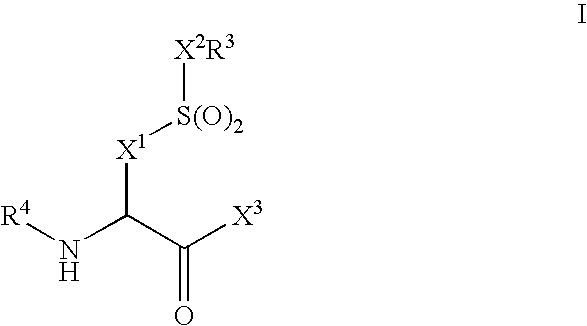Compounds and compositions as cathepsin inhibitors
a technology of compound and composition, applied in the field of compound, can solve the problems of pathological consequences and the inability to fully inhibit the activity of cysteine proteases, and achieve the effect of preventing, inhibiting or ameliorating the pathology and/or symptomatology of the diseas
- Summary
- Abstract
- Description
- Claims
- Application Information
AI Technical Summary
Benefits of technology
Problems solved by technology
Method used
Image
Examples
example 1
Morpholine-4-carboxylic acid [1-(1-benzoyl-4-oxo-pyrrolidin-3-ylcarbamoyl)-2-phenylmethanesulfonyl-ethyl]-amide
[0135]
[0136]2-[(Morpholine-4-carbonyl)-amino]-3-phenylmethanesulfonyl-propionic acid (1 g, 2.8 mmol), 3-amino-4-hydroxy-pyrrolidine-1-carboxylic acid tert-butyl ester (700 mg, 3.46 mmol) prepared as in Reference 1, EDC (1.5 g, 7.8 mmol), and HOBt (1.5 g, 9.6 mmol) were combined. Dichloromethane (10 mL) was added and then 4-methylmorpholine (1.5 mL). The mixture was stirred at ambient temperature for 2 hours. After dilution with ethyl acetate (200 mL) the solution was washed with saturated aqueous NaHCO3 (100 mL) and brine (100 mL), dried with MgSO4 and evaporated under vacuum. 3-Hydroxy-4-{2-[(morpholine-4-carbonyl)-amino]-3-phenylmethanesulfonyl-propionylamino}-pyrrolidine-1-carboxylic acid tert-butyl ester (1.05 g, 1.94 mmol) was obtained as yellowish foam and was dissolved in dichloromethane (6 mL). Trifluoroacetic acid (6 mL) was added and the mixture was stirred at amb...
example 2
Morpholine-4-carboxylic acid [1-(1-benzenesulfonyl-4-oxo-pyrrolidin-3-ylcarbamoyl) 2-phenylmethanesulfonyl-ethyl]-amide
[0139]
[0140]Morpholine-4-carboxylic acid [1-(1-benzenesulfonyl-4-oxo-pyrrolidin-3-ylcarbamoyl)2-phenylmethanesulfonyl-ethyl]-amide was prepared following the procedure detailed in Example 1, substituting benzenesulfonyl chloride for benzoyl chloride; 1H NMR: (DMSO) [8.35 (d, J=7.4 Hz), 8.28 (d, J=7.6 Hz), 1H], 7.87–7.62 (m, 5H), 7.41 7.32 (m, 5H), 7.06–6.98 (m, 1H), 4.72–4.60 (m, 1H), 4.45 (s, 2H), 4.42–4.23 (m, 1H), 3.92–3.79 (m, 2H), 3.55–3.20 (m, 11H), 3.06–2.97 (m, 1H). MS: (M+H)+ 579.
example 3
4-{2-[(Morpholine-4-carbonyl)-amino]-3-phenylmethanesulfonyl-propionylamino}-3-oxo-azepane-1-carboxylic acid benzyl ester
[0141]
[0142]Crude 4-amino-3-hydroxy-azepane-1-carboxylic acid benzyl ester (150 mg, 0.57 mmol) prepared as in Reference 2, 2-[(morpholine-4-carbonyl)-amino]-3-phenylmethanesulfonyl-propionic acid (400 mg, 1.12 mmol), EDC (400 mg, 2.1 mmol), and HOBt (400 mg, 2.5 mmol) were combined. Dichloromethane (10 mL) was added followed by 4-methylmorpholine (0.5 mL). The mixture was stirred at ambient temperature for 2 hours. After dilution with ethyl acetate (100 mL) the solution was washed with 1N HCl, saturated aqueous NaHCO3 and brine, dried with MgSO4 and evaporated under vacuum. The residue was purified by flash chromatography (ethyl acetate / methanol 9: 1) to yield 3-hydroxy-4-{2-[(morpholine-4-carbonyl)-amino]-3-phenylmethanesulfonyl-propionyl-amino}-azepane-1-carboxylic acid benzyl ester (320 mg).
[0143]3-Hydroxy-4-{2-[(morpholine-4-carbonyl)-amino]-3-phenylmethanesul...
PUM
 Login to View More
Login to View More Abstract
Description
Claims
Application Information
 Login to View More
Login to View More - R&D
- Intellectual Property
- Life Sciences
- Materials
- Tech Scout
- Unparalleled Data Quality
- Higher Quality Content
- 60% Fewer Hallucinations
Browse by: Latest US Patents, China's latest patents, Technical Efficacy Thesaurus, Application Domain, Technology Topic, Popular Technical Reports.
© 2025 PatSnap. All rights reserved.Legal|Privacy policy|Modern Slavery Act Transparency Statement|Sitemap|About US| Contact US: help@patsnap.com



